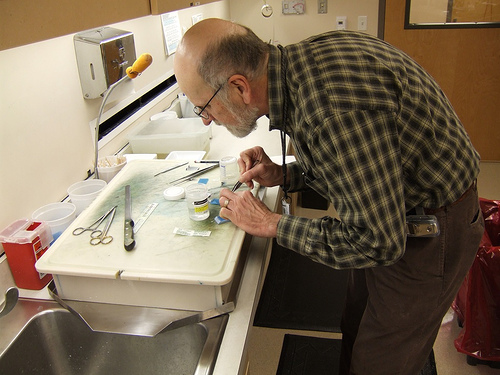In a majority of cases, breast cancer diagnosis is done only after the associated signs and symptoms start to appear.

When Should You Opt For Breast Cancer Diagnosis?
Women are advised to undergo cancer screening regularly as it can help ensure that the breast cancer is detected at an early stage. This would in turn help to evaluate the prognosis and the choice of treatment. Timely treatment can ensure that the cancer is not given a chance to spread to the other areas of the breast and the body.
Breast Cancer Diagnosis – The Variety Of Tests Involved
Some of the tests commonly used to detect breast cancer are:
-
Breast Self-Exam:
This is the simplest way to detect any lumps in the breast. Any unusual changes like discoloration, dimpling, sores, skin peeling, or any changes associated with the nipple should be brought to the notice of the doctor. The doctor will then clinically examine the breast and the underarms for any signs of lumps or tumors. If any abnormalities are found, he is likely to advise further tests for breast cancer diagnosis.
-
Imaging Tests:
(a) Mammogram:
This is a common method used to screen the breast using a specific kind of X-rays to check for abnormalities in the breast tissue.
(b) Ultrasound:
In this method, sound waves are used to create images of different sections of the breast. By careful examination of the images, the doctor is able to identify any abnormality, such as thickened tissue, lump, or tumor.
(c) Magnetic Resonance Imaging (MRI):
This test is usually used when a lump or a tumor is found during a clinical examination. This method uses magnetic and radio waves to create images of the breast, which helps in determining the stage of the cancer and also to check if the cancer has spread to other areas of the breast and to other the organs of the body.
-
Surgical Tests:
(a) Biopsy:
A sample of the breast cells that show abnormality is taken to check for the presence of cancerous cells and to determine the stage of the cancer.
(b) Sentinel Node Biopsy:
This is commonly used to check if the cancer has spread to the lymph nodes located under the arms.
(c) Ductal Lavage:
This test is performed by taking a sample from the mild ducts using a small thin tube, and then microscopically examining the cells for the presence of cancer.
-
Molecular Analysis:
In many cases, the doctors advise tests that can help determine the genetic makeup of the tumor cells, and then suggest the best treatment options.
(a) Human Epidermal Growth Factor 2 (HER2) Test:
Approximately 20 to 25% of breast cancer cases have an increased number of the HER2 gene in the cells. This gene generates the protein required for the tumor cells to grow rapidly. It is important to know the status of the HER2 gene as it helps in prescribing specific drugs to treat the cancer effectively.
(b) Estrogen And Progesterone Receptor Test:
About 70 to 80% of breast cancer patients have estrogen and progesterone receptors in their cells. It is important to know the status of these receptors as it helps determine the ideal choice of treatment and identify the risk of recurrence.
(c) Ki67:
This is a specific test used to determine the time taken by the tumor cells to divide, and it helps outline the best and most effective form of treatment.
-
Genetic Test:
This test, conducted to determine the risk of recurrence in individuals with breast cancer, screens the genes associated with breast cancer. There are 2 kinds of genetic tests that are commonly used:
(a) Mammaprint:
Mammaprint, a test for breast cancer diagnosis, has been approved by the US FDA. In this test, about 70 genes are screened to check for mutations that would determine the risk of developing the cancer again.
(b) Oncotype Dx:
This test looks at 16 genes associated with breast cancer and 5 reference genes, to evaluate the risk of the patient developing breast cancer again within 10 years after being diagnosed with stage I or II cancer.
-
Blood Test:
Several parameters in the blood have to be evaluated when a woman is suspected to have breast cancer. For example, blood electrolytes (calcium and potassium), complete blood count, total bilirubin count, and enzymes (ALT and AST) are some of the parameters that appear abnormal in case of breast cancer. The tumor marker is also measured in many cases in order to monitor the recurrence of cancer.
-
Additional Tests:
Doctors advise some additional tests depending on the symptoms and the stage of the cancer. Some of them are:
(a) Chest X-ray:
This is usually done to check if the cancer has spread to the lungs.
(b) Bone Scan:
A radioactive tracer is used to scan the bones to see if the cancer has spread to the bones as well.
(c) Computed Tomography:
This scan is used to screen for tumors in lymph nodes, lungs, bones, and the liver.
(d) Positron Emission Tomography (PET):
PET is conducted by injecting a small quantity of radioactive glucose into the patient’s body. The cancer cells absorb the dye more than the normal cells as they require more energy to divide. The dye gets picked up by the scanner, thus indicating the presence of cancer.
Breast cancer, like other forms of cancer, can prove fatal if left undetected and untreated. It is best to undergo regular screenings for breast cancer diagnosis, to ensure that in case of the presence of breast cancer, it can be treated effectively at the earliest.